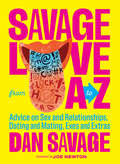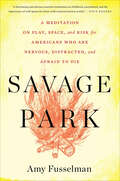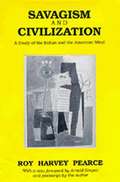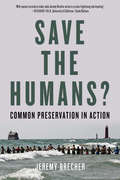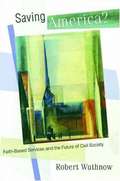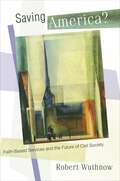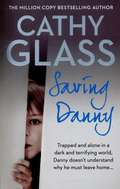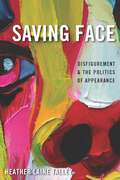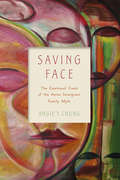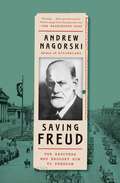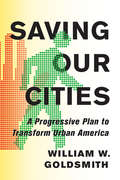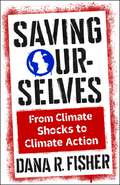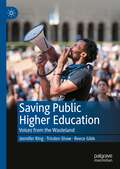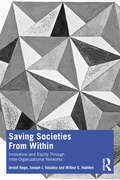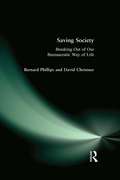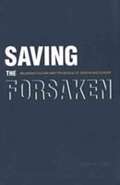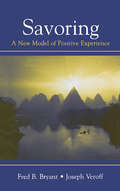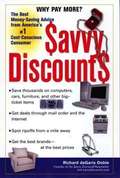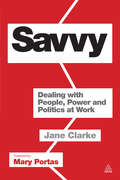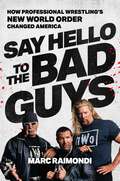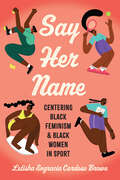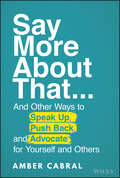- Table View
- List View
Savage Love from A to Z: Advice on Sex and Relationships, Dating and Mating, Exes and Extras
by Dan SavageAmerica's premier sex advice columnist takes on edgier-than-ever sex-positive topics with his signature candor in his first illustrated collection of adults-only essays, coinciding with the 30th anniversary of the Savage Love column. Dan Savage has been talking frankly about sex and relationships for 30 years, and has built an international following thanks to his sex-positive Savage Love column and podcast. To celebrate this milestone comes Savage Love from A to Z, an illustrated collection of 26 never-before-published essays that provides a thoughtful, frank dive into Savage's trademark phrases and philosophies. This hardcover book is for anyone who's had sex, is currently having sex, or hopes to have sex!Essays cover a variety of topics: • B Is for Boredom • F Is for Fuck First • G Is for GGG (Good Giving Game) • M Is for MonogamishWhether he's talking about issues like compatibility or specific sex acts, you can be sure he's giving it to you straight. Short excerpts from his classic columns kick off each essay and cheeky illustrations by his longtime collaborator Joe Newton complement the topic at hand. Savage has moved the needle toward a more open discourse around sex, relationships, and intimacy, and this book will both inspire and inform his legions of fans. An ideal stocking stuffer!
Savage Park: A Meditation on Play, Space, and Risk for Americans Who Are Nervous, Distracted, and Afraid to Die
by Amy Fusselman"A fascinating and daresay essential meditation on childhood, parenthood, and the importance of wild spaces for those wild creatures known as kids."—Dave Eggers How fully can the world be explored when you are focused on trying not to die? This is the question that lies at the heart of Amy Fusselman&’s Savage Park. America is the land of safety, of protecting children to make sure that nothing can possibly hurt them. But while on a trip to Tokyo with her family, Fusselman stumbled upon an adventure playground called Hanegi Playpark, where children sawed wood, hammered nails, and built open fires. Her conceptions of space, risk, and play were shattered. In asking us to reexamine fundamental ideas about our approaches to space and risk and how we pass these concepts down to our children, Fusselman also asks us to look at the world in a different way. Perhaps it isn&’t variety, but fear that is the spice of life. This startling revelation is at the heart of Savage Park, and will make readers look at the world in a whole new way. &“I yield to no one in my admiration for Amy Fusselman&’s work. Her new book, Savage Park, further explores with astonishing power, eloquence, precision, and acid humor her obsessive, necessary theme: the gossamer-thin separation between life and death.&” —David Shields, author of Reality Hunger &“In this unusually refreshing meditation (which reads like a novel), we are given a tour of the space around and within us. With poetic efficiency Amy Fusselman reveals what makes us savage or not; why secret, wild spaces are essential; and why playing should be taken seriously.&” —Philippe Petit, high-wire artist
Savagism and Civilization: A Study of the Indian and the American Mind
by Roy Harvey PearceFirst published in 1953, revised in 1964, and presented here with a new foreword by Arnold Krupat and new postscript by the author, Roy Harvey Pearce's "Savagism and Civilization" is a classic in the genre of history of ideas. Examining the political pamphlets, missionaries' reports, anthropologists' accounts, and the drama, poetry, and novels of the 18th and early 19th centuries, Professor Pearce traces the conflict between the idea of the noble savage and the will to Christianize the heathen and appropriate their land, which ended with the near extermination of Native American culture.
Save Our Land, Save Our Towns: A Plan For Pennsylvania
by Thomas Hylton Blair SeitzPulitzer Prize-winning jounalist Thomas Hylton outlines in a readable style with Seitz's award-winning photography a plan for Pennsylvania - or any state - to preserve farmland and forests, and revive our cities and neighborhoods - as well as lower our cost of living. Winner of National Trust for Historic Preservation award.
Save the Bees!
by Lisa Jean Moore Mary KosutGrappling with the strange phenomenon of colony collapse disorder--the baffling disappearance of all bees from a hive that is often blamed for the honeybee's increasingly endangered status--New York City's hobbyist beekeeping communities have gone green. Lisa Jean Moore and Mary Kosut introduce beekeepers of all stripes: the careful cultivators of 'scientific' beekeeping groups, the passionately political radical 'backwards' beekeepers who hope to return the species to its most natural state, and DIY-influenced 'hipster' beekeepers who share a holistic approach to lowering their environmental impact. Though their approaches may differ, these beekeepers agree on one thing: to save the bee is to save our planet.
Save the Humans?: Common Preservation in Action
by Jeremy BrecherWe the people of the world are creating the conditions for our own self-extermination, whether through the bang of a nuclear holocaust or the whimper of an expiring ecosphere. Today our individual self-preservation depends on common preservation—cooperation to provide for our mutual survival and well-being. For half a century Jeremy Brecher has been studying and participating in social movements that have created new forms of common preservation. Brecher traces a path that leads from the sitdown strikes on the pyramids of ancient Egypt through America's mass strikes and labor revolts to the struggle against economic globalization to today's battles against climate change. Weaving together personal experience, scholarly research, and historical interpretation, Jeremy Brecher shows how we can construct a "human survival movement" that could "save the humans." He sums up the theme of this book: "I have seen common preservation—and it works." For those seeking an understanding of social movements and an alternative to denial and despair, there is simply no better place to look than Save the Humans?
Saving America: Faith-Based Services and the Future of Civil Society
by Robert WuthnowThe author discusses whether congregations are effective vehicles for providing broad-based social programs and whether they are actually fostering the civil society.
Saving America?: Faith-Based Services and the Future of Civil Society
by Robert WuthnowOn January 29, 2001, President George W. Bush signed an executive order creating the White House Office of Faith-Based and Community Initiatives. This action marked a key step toward institutionalizing an idea that emerged in the mid-1990s under the Clinton administration--the transfer of some social programs from government control to religious organizations. However, despite an increasingly vocal, ideologically charged national debate--a debate centered on such questions as: What are these organizations doing? How well are they doing it? Should they be supported with tax dollars?--solid answers have been few. In Saving America? Robert Wuthnow provides a wealth of up-to-date information whose absence, until now, has hindered the pursuit of answers. Assembling and analyzing new evidence from research he and others have conducted, he reveals what social support faith-based agencies are capable of providing. Among the many questions he addresses: Are congregations effective vehicles for providing broad-based social programs, or are they best at supporting their own members? How many local congregations have formal programs to assist needy families? How much money do such programs represent? How many specialized faith-based service agencies are there, and which are most effective? Are religious organizations promoting trust, love, and compassion? The answers that emerge demonstrate that American religion is helping needy families and that it is, more broadly, fostering civil society. Yet religion alone cannot save America from the broad problems it faces in providing social services to those who need them most. Elegantly written, Saving America? represents an authoritative and evenhanded benchmark of information for the current--and the coming--debate.
Saving Danny
by Cathy GlassDanny was petrified and clung to me in desperation as I carried him to my car. Trapped in his own dark world, he couldn't understand why his parents no longer loved or wanted him, and were sending him away. While Danny's parents have everything they could wish for in material terms, they are unable to care for their only child. This is where Cathy comes in. On a cold dark evening Danny finds a place in her home where he can be himself; away from his parents' impatience and frustration. Often in his own little world, six-year-old Danny finds it difficult to communicate, finding solace in his best friend and confidant George - his rabbit. Cathy quickly becomes aware of his obsessively meticulous behaviour in addition to his love of patterns, he sees them everywhere and creates them at any opportunity - in his play and also with his food. She realises that patience is the key to looking after Danny as well as her well-tried strategies for managing children's behaviour. With his father refusing to cooperate, it becomes increasingly likely that Danny will be living with Cathy permanently until she gets an opportunity to speak her piece.
Saving Face: Disfigurement and the Politics of Appearance
by Heather Laine TalleyWinner, Body and Embodiment Award presented by the American Sociological AssociationImagine yourself without a face—the task seems impossible. The face is a core feature of our physical identity. Our face is how others identify us and how we think of our ‘self’. Yet, human faces are also functionally essential as mechanisms for communication and as a means of eating, breathing, and seeing. For these reasons, facial disfigurement can endanger our fundamental notions of self and identity or even be life threatening, at worse. Precisely because it is so difficult to conceal our faces, the disfigured face compromises appearance, status, and, perhaps, our very way of being in the world.In Saving Face, sociologist Heather Laine Talley examines the cultural meaning and social significance of interventions aimed at repairing faces defined as disfigured. Using ethnography, participant-observation, content analysis, interviews, and autoethnography, Talley explores four sites in which a range of faces are “repaired:” face transplantation, facial feminization surgery, the reality show Extreme Makeover, and the international charitable organization Operation Smile,. Throughout, she considers how efforts focused on repair sometimes intensify the stigma associated with disfigurement. Drawing upon experiences volunteering at a camp for children with severe burns, Talley also considers alternative interventions and everyday practices that both challenge stigma and help those seen as disfigured negotiate outsider status.Talley delves into the promise and limits of facial surgery, continually examining how we might understand appearance as a facet of privilege and a dimension of inequality. Ultimately, she argues that facial work is not simply a conglomeration of reconstructive techniques aimed at the human face, but rather, that appearance interventions are increasingly treated as lifesaving work. Especially at a time when aesthetic technologies carrying greater risk are emerging and when discrimination based on appearance is rampant, this important book challenges us to think critically about how we see the human face.
Saving Face: How to Preserve Dignity and Build Trust
by Maya Hu-Chan"Maya Hu-Chan shares a blueprint for becoming a more empathetic, self-aware, and inclusive leader. Saving Face guides us to consider different perspectives, to think first and speak last, and to respect others above all else."—Frances Hesselbein, former CEO, Girl Scouts of the USA, and Presidential Medal of Freedom recipientOrganizations now need to attract, retain, and motivate teams and employees across distance, time zones, and cultural differences. Building authentic and lasting human relations may be the most important calling for leaders in this century. According to management and global leadership specialist Maya Hu-Chan, the concept of "saving face" can help any leader preserve dignity and create more empathetic cross-cultural relationships. "Face" represents one's self-esteem, self-worth, identity, reputation, status, pride, and dignity. Saving face is often understood as saving someone from embarrassment, but it's also about developing an understanding of the background and motivations of others to discover the unique facets we all possess. Without that understanding, we risk causing others to lose face without even knowing it. Hu-Chan explains saving face through anecdotes and practical tools, such as her BUILD leadership model (Benevolence, Understanding, Interacting, Learning, and Delivery). This book illustrates how we can give face to create positive first impressions, avoid causing others to lose face, and, most importantly, build trust and lasting relationships inside and outside the workplace.
Saving Face: The Emotional Costs of the Asian Immigrant Family Myth
by Angie Y. ChungTiger Mom. Asian patriarchy. Model minority children. Generation gap. The many images used to describe the prototypical Asian family have given rise to two versions of the Asian immigrant family myth. The first celebrates Asian families for upholding the traditional heteronormative ideal of the "normal (white) American family" based on a hard-working male breadwinner and a devoted wife and mother who raises obedient children. The other demonizes Asian families around these very same cultural values by highlighting the dangers of excessive parenting, oppressive hierarchies, and emotionless pragmatism in Asian cultures.<P><P> Saving Face cuts through these myths, offering a more nuanced portrait of Asian immigrant families in a changing world as recalled by the people who lived them first-hand: the grown children of Chinese and Korean immigrants. Drawing on extensive interviews, sociologist Angie Y. Chung examines how these second-generation children negotiate the complex and conflicted feelings they have toward their family responsibilities and upbringing. Although they know little about their parents' lives, she reveals how Korean and Chinese Americans assemble fragments of their childhood memories, kinship narratives, and racial myths to make sense of their family experiences. However, Chung also finds that these adaptive strategies come at a considerable social and psychological cost and do less to reconcile the social stresses that minority immigrant families endure today.<P> Saving Face not only gives readers a new appreciation for the often painful generation gap between immigrants and their children, it also reveals the love, empathy, and communication strategies families use to help bridge those rifts.
Saving Freud: The Rescuers Who Brought Him to Freedom
by Andrew NagorskiA dramatic true story about Sigmund Freud&’s last-minute escape to London following the German annexation of Austria and the group of friends who made it possible.In March 1938, German soldiers crossed the border into Austria and Hitler absorbed the country into the Third Reich. Anticipating these events, many Jews had fled Austria, but the most famous Austrian Jew remained in Vienna, where he had lived since early childhood. Sigmund Freud was eighty-one years old, ill with cancer, and still unconvinced that his life was in danger. But several prominent people close to Freud thought otherwise, and they began a coordinated effort to persuade Freud to leave his beloved Vienna and emigrate to England. The group included a Welsh physician, Napoleon&’s great-grandniece, an American ambassador, Freud&’s devoted youngest daughter Anna, and his personal doctor. Saving Freud is the story of how this remarkable collection of people finally succeeded in coaxing Freud, a man who seemingly knew the human mind better than anyone else, to emerge from his deep state of denial about the looming catastrophe, allowing them to extricate him and his family from Austria so that they could settle in London. There Freud would live out the remaining sixteen months of his life in freedom. This book is both an incisive new biography of Freud and a group biography of the extraordinary friends who saved Freud&’s life.
Saving Our Cities: A Progressive Plan to Transform Urban America
by William W. GoldsmithIn Saving Our Cities, William W. Goldsmith shows how cities can be places of opportunity rather than places with problems. With strongly revived cities and suburbs, working as places that serve all their residents, metropolitan areas will thrive, thus making the national economy more productive, the environment better protected, the citizenry better educated, and the society more reflective, sensitive, and humane.Goldsmith argues that America has been in the habit of abusing its cities and their poorest suburbs, which are always the first to be blamed for society's ills and the last to be helped. As federal and state budgets, regulations, and programs line up with the interests of giant corporations and privileged citizens, they impose austerity on cities, shortchange public schools, make it hard to get nutritious food, and inflict the drug war on unlucky neighborhoods.Frustration with inequality is spreading. Parents and teachers call persistently for improvements in public schooling, and education experiments abound. Nutrition indicators have begun to improve, as rising health costs and epidemic obesity have led to widespread attention to food. The futility of the drug war and the high costs of unwarranted, unprecedented prison growth have become clear. Goldsmith documents a positive development: progressive politicians in many cities and some states are proposing far-reaching improvements, supported by advocacy groups that form powerful voting blocs, ensuring that Congress takes notice. When more cities forcefully demand enlightened federal and state action on these four interrelated problems—inequality, schools, food, and the drug war—positive movement will occur in traditional urban planning as well, so as to meet the needs of most residents for improved housing, better transportation, and enhanced public spaces.<
Saving Ourselves: From Climate Shocks to Climate Action (Society and the Environment)
by Dana R. FisherWe've known for decades that climate change is an existential crisis. For just as long, we've seen the complete failure of our institutions to rise to the challenge. Governments have struggled to meet even modest goals. Fossil fuel interests maintain a stranglehold on political and economic power. Even though we have seen growing concern from everyday people, civil society has succeeded only in pressuring decision makers to adopt watered-down policies. All the while, the climate crisis worsens. Is there any hope of achieving the systemic change we need?Dana R. Fisher argues that there is a realistic path forward for climate action—but only through mass mobilization that responds to the growing severity and frequency of disastrous events. She assesses the current state of affairs and shows why public policy and private-sector efforts have been ineffective. Spurred by this lack of progress, climate activism has become increasingly confrontational. Fisher examines the radical flank of the climate movement: its emergence and growth, its use of direct action, and how it might evolve as the climate crisis worsens. She considers when and how activism is most successful, identifying the importance of creating community, capitalizing on shocking moments, and cultivating resilience. Clear-eyed yet optimistic, Saving Ourselves offers timely insights on how social movements can take power back from deeply entrenched interests and open windows of opportunity for transformative climate action.
Saving Public Higher Education: Voices from the Wasteland
by Jennifer Ring Trisden Shaw Reece GibbIn this book, eleven recent college graduates describe in vivid detail their journeys from racially segregated, underfunded public schools to a state university, and the obstacles they encountered along the way. Chapters highlight personal accounts of poverty, violence, and bullying in childhood, the persistence of racism on the university campus and the inability of faculty and administrators to combat it. Overcoming all-too-common barriers, these eleven students persevered, earned their degrees and continued on to graduate school and professional careers. The authors conclude the book with policy proposals that not only address the issues raised by the students, but that would also restore public education to its original role as an engine of opportunity and driver of democracy.
Saving Societies From Within: Innovation and Equity Through Inter-Organizational Networks
by Jerald Hage Joseph J. Valadez Wilbur C. HaddenMoving beyond existing models from economics and political science, this book shows how crises in capitalism and democracy can be solved with Systemic coordinated inter-organizational networks.It offers a new model of societal coordination that builds cooperation and trust while solving today’s modern and complex practical problems: Systemic coordinated inter-organizational networks (SCIONs). It details how SCIONs can quickly catalyze organizational change among interorganizational network members while providing a general framework for characterizing individual and organizational change. The chapters apply these theoretical ideas in an epic case study of the rebuilding of the health care system in rural Nicaragua after a major natural disaster (Hurricane Mitch). They provide lessons for public health program managers while contributing to the literatures on modes of coordination and on social capital.The book is a vital text for upper-division courses on management, inter-organizational collaboration, crisis management and public health.
Saving Society: Breaking Out of Our Bureaucratic Way of Life
by Bernard S Phillips David ChristnerWhy do many problems throughout the world seem to be getting worse? Saving Society argues that a dramatic change in our mode of thinking is required. The authors show how many of our fundamental assumptions lead to an overly bureaucratic approach, blocking solutions to many of our problems. They contrast our present emotional repression and conforming behaviour with a more liberated form of perception, thought and emotional expression, which could allow us to break out of these bureaucratic routines. Saving Society shows how this alternative approach might lay the basis for more effective and democratic institutions.
Saving the Forsaken: Religious Culture and the Rescue of Jews in Nazi Europe
by Pearl M. OlinerPearl M. Oliner examines data on Christian rescuers and nonrescuers of Jews during the Holocaust to shed light on these important questions. Drawing on interviews with more than five hundred Christians--Protestant and Catholic, very religious, irreligious, and moderately religious--rescuers and nonrescuers living in Nazi-occupied Europe, Oliner offers a sociological perspective on the values and attitudes that distinguished each group. She presents several case studies of rescuers and nonrescuers within each group and then interprets the individual's behavior as it relates to his or her group. She finds that the value patterns of the religious groups differ significantly from one another, and she is able to highlight those factors that appear to have contributed most toward rescue within each group.
Savoring: A New Model of Positive Experience
by Fred B. Bryant Joseph VeroffThis book is about savoring life—the capacity to attend to the joys, pleasures, and other positive feelings that we experience in our lives. The authors enhance our understanding of what savoring is and the conditions under which it occurs. Savoring provides a new theoretical model for conceptualizing and understanding the psychology of enjoyment and the processes through which people manage positive emotions. The authors review their quantitative research on savoring, as well as the research of others, and provide measurement instruments with scoring instructions for assessing and studying savoring. Authors Bryant and Veroff outline the necessary preconditions that must exist for savoring to occur and distinguish savoring from related concepts such as coping, pleasure, positive affect, emotional intelligence, flow, and meditation. The book’s lifespan perspective includes a conceptual analysis of the role of time in savoring. Savoring is also considered in relation to human concerns, such as love, friendship, physical and mental health, creativity, and spirituality. Strategies and hands-on exercises that people can use to enhance savoring in their lives are provided, along with a review of factors that enhance savoring. Savoring is intended for researchers, students, and practitioners interested in positive psychology from the fields of social, clinical, health, and personality psychology and related disciplines. The book may serve as a supplemental text in courses on positive psychology, emotion and motivation, and other related topics. The chapters on enhancing savoring will be especially attractive to clinicians and counselors interested in intervention strategies for positive psychological adjustment.
Savvy Discounts: The Best Money-saving Advice From America's #1 Cost-conscious Consumer
by Richard Degaris DobleSavvy shoppers can get the very best for the lowest possible price - all from reputable dealers who stand behind their merchandise. This comprehensive book is packed with how-to advice, entertaining stories, and tips to guide readers through the entire shopping experience-from what you need to know before stepping into a shop to what you should do after the sale. With hundreds of ingenious money-saving ideas, this is the perfect guide for every aspiring smart shopper.
Savvy: Dealing with People, Power and Politics at Work
by Jane ClarkeShortlisted for the CMI Management Book of the Year 2012http://yearbook.managers.org.uk/the-commuters-read-shortlistDealing with office politics, conflict and difficult people at work, without compromising your values and integrity, can be tricky. With case studies and examples, Savvy will help you understand colleagues' behaviour and power dynamics at work, and learn how to negotiate them successfully.Practical and insightful, Savvy will enable you to master the necessary skills to deal with difficult situations. It includes step-by-step advice on how tobuild a network, develop the right mindset, handle conflict, manage your boss, influence others and deal with a bully.Savvy is the essential office survival guide that will help you to boost your career and ensure your professional success.
Say Hello to the Bad Guys: How Professional Wrestling's New World Order Changed America
by Marc RaimondiFrom ESPN reporter Marc Raimondi comes a compelling, gripping narrative history of professional wrestling&’s legendary faction, The NWO (New World Order), from their inception in 1996 to their influence on American pop culture today. In 1996, professional wrestling was one of the most watched sports on cable television, with more than 5 million people tuning in every week. And in the late 1990s, pro-wrestling was the hottest thing in American pop culture, with companies making millions in action figures, video games, and simple black t-shirts emblazoned with three little letters: NWO. The NWO, or New World Order, became a business like no other, and was responsible for the explosive ratings and rabid fanbase. It started with an ingenious storyline starring Scott Hall, Kevin Nash, and the titular Hollywood Hogan—Hulk Hogan gone bad. Together, they formed a new era of characters to root for: The Bad Guys. Never before had audiences cheered for the villains, rooting for them over the heroes. The NWO broke down wrestling&’s fourth wall in a clever new way, blurring the lines between fiction and reality. And suddenly, watching professional wrestling not only became socially acceptable, but a necessity if you wanted to stay up to date with pop culture. Their impact was infectious and long-lasting. It was entertainment that shaped a generation. Written by Marc Raimondi, a current ESPN reporter with nearly twenty years of experience in journalism, this narrative history explores professional wrestling&’s most popular faction and how their existence influenced American culture like never before.
Say Her Name: Centering Black Feminism and Black Women in Sport (Critical Issues in Sport and Society)
by Letisha Engracia BrownSay Her Name: Centering Black Feminism and Black Women in Sports offers an in-depth look into the lived experiences of Blackgirlwomen as athletes, activists, and everyday people through a Black feminist lens. With so much research on race centered on Black men and gender research focusing on white women, Say Her Name offers a necessary conversation that places Blackgirlwomen at the center of discussion. Say Her Name delves deeply into issues of gender, the politics of punishment, athlete activism, the politics of Black hair, fingernails and fashion, and the representation and commodification of Blackgirlwomen in sport and society. An entry point into the growing research in sport studies and beyond from a Black feminist lens, Say Her Name offers a clear window into the power and potential of nuanced examinations of sport. As a reflection of the larger social world, sport provides a framework for understanding larger social issues, including racism, sexism, and misogynoir. Blackgirlwomen have varied experiences in sport, and Say Her Name provides a window into those experiences. The book discusses Black women in sports including the South African runner Caster Semenya and the American runners Florence Griffith Joyner and Sha’Carri Richardson, as well as Venus and Serena Williams, Gabby Douglas, and Simone Biles. The women in this book have lived experiences that speak to the larger experiences of Black women and girls in sport and society, while also leaning into a larger discussion of the importance of the social movement #SayHerName.
Say More About That: ...And Other Ways to Speak Up, Push Back, and Advocate for Yourself and Others
by Amber CabralConcrete strategies to call out wrongdoing at home, at work, at school, and elsewhere In Say More About That, veteran inclusion strategist, coach, writer, and speaker Amber Cabral delivers an incisive and practical guide to assertively addressing inequitable treatment you see at home, work, school, and other settings. The book offers a complete communications toolkit for equity advocacy you can deploy on your own behalf and on behalf of others. You&’ll get the tactics, context, and tools that make being brave and speaking up a lot easier. You&’ll also find: A thorough discussion of the fundamentals of inclusion and equity, including concepts of advocacy and allyship, privilege, and identity An examination of the social landscape that makes speaking up so daunting Explorations of the most effective language and tactics you can use when you make a stand for yourself or others The perfect resource for underrepresented professionals, allies, advocates, and people seeking to make a positive difference in the world, Say More About That is the assertiveness manual you need if you&’ve been meaning to speak up but are worried about being drowned out.
